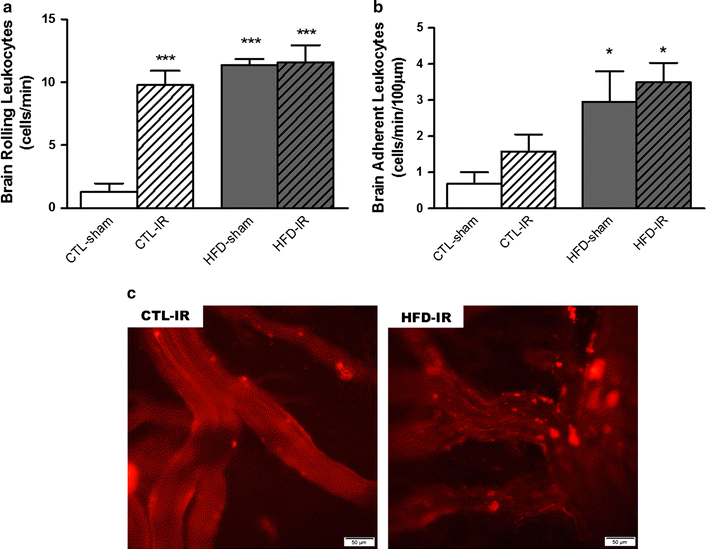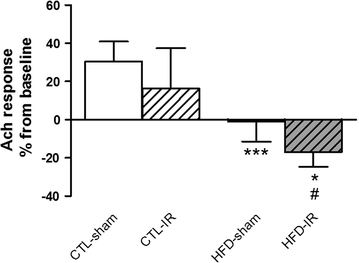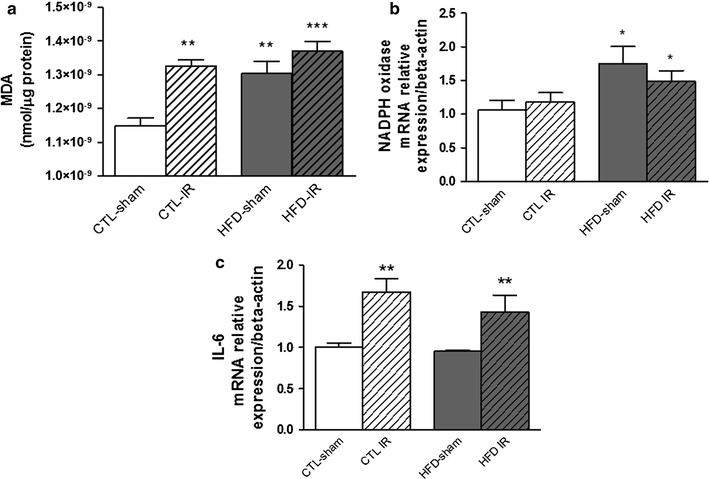Cerebral microvascular dysfunction in metabolic syndrome is exacerbated by ischemia-reperfusion injury
- PMID: 28886695
- PMCID: PMC5591496
- DOI: 10.1186/s12868-017-0384-x
Cerebral microvascular dysfunction in metabolic syndrome is exacerbated by ischemia-reperfusion injury
Abstract
Background: Metabolic syndrome (MetS) is associated with an increased risk of cerebrovascular diseases, including cerebral ischemia. Microvascular dysfunction is an important feature underlying the pathophysiology of cerebrovascular diseases. In this study, we aimed to investigate the impacts of ischemia and reperfusion (IR) injury on the cerebral microvascular function of rats with high-fat diet-induced MetS.
Results: We examined Wistar rats fed a high-fat diet (HFD) or normal diet (CTL) for 20 weeks underwent 30 min of bilateral carotid artery occlusion followed by 1 h of reperfusion (IR) or sham surgery. Microvascular blood flow was evaluated on the parietal cortex surface through a cranial window by laser speckle contrast imaging, functional capillary density, endothelial function and endothelial-leukocyte interactions by intravital videomicroscopy. Lipid peroxidation was assessed by TBARs analysis, the expression of oxidative enzymes and inflammatory markers in the brain tissue was analyzed by real-time PCR. The cerebral IR in MetS animals induced a functional capillary rarefaction (HFD IR 117 ± 17 vs. CTL IR 224 ± 35 capillary/mm2; p < 0.05), blunted the endothelial response to acetylcholine (HFD IR -16.93% vs. CTL IR 16.19% from baseline inner diameter p < 0.05) and increased the endothelial-leukocyte interactions in the venules in the brain. The impact of ischemia on the cerebral microvascular blood flow was worsened in MetS animals, with a marked reduction of cerebral blood flow, exposing brain tissue to a higher state of hypoxia.
Conclusions: Our results demonstrate that during ischemia and reperfusion, animals with MetS are more susceptible to alterations in the cerebral microcirculation involving endothelial dysfunction and oxidative stress events.
Keywords: Cerebral microvascular blood flow; Ischemia and reperfusion; Laser speckle contrast imaging (LSCI); Metabolic syndrome.
Figures





References
-
- Sacco RL, Kasner SE, Broderick JP, Caplan LR, Connors JJ, Culebras A, Elkind MS, George MG, Hamdan AD, Higashida RT, et al. An updated definition of stroke for the 21st century: a statement for healthcare professionals from the American Heart Association/American Stroke Association. Stroke. 2013;44(7):2064–2089. doi: 10.1161/STR.0b013e318296aeca. - DOI - PMC - PubMed
-
- Lam DW, LeRoith D. Metabolic syndrome. Endotext. In: De Groot LJ, Beck-Peccoz P, Chrousos G, Dungan K, Grossman A, Hershman JM, Koch C, McLachlan R, New M, Rebar R et al., editors. South Dartmouth MA: MDText.com, Inc.; 2000.
Publication types
MeSH terms
LinkOut - more resources
Full Text Sources
Other Literature Sources
Medical

